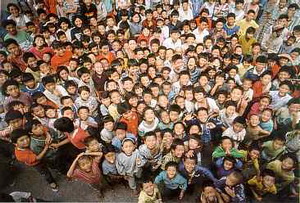
From its humble beginning forty nine years ago, Tibetan Children’s Village has today become a thriving, integrated educational community for destitute Tibetan children in exile, as well as for hundreds of those escaping from Tibet every year. It has established branches in India extending from Ladakh in the North to Bylakuppe in South, with over 16,726 children under its care.
Forty nine years is not a short period in anyone’s life and certainly not in the life of TCV. Tibetan Children’s Village realizes the enormous responsibility it bears for the destiny of our Tibetan children and for the goodwill of the thousands of its donors and friends around the world who have sustained it through all these years.
Today, we are proud to see young people from our villages serving the Tibetan community in different capacities and, at the same time, accept that there are a few children who have not fared so well. In this respect, extensive efforts are being made to further improve the lives of our children, bearing in mind the lessons and shortcomings we have experienced in the past. Though much has been achieved, we still have a long way to go in fulfilling our aims and objectives of providing the children under our care with the necessary resources and the opportunities to develop their abilities to the fullest. As has been highlighted by His Holiness the Dalai Lama in his message on our 35th Anniversary; "the future direction of our programme will be in the field of further education in specialised studies to meet the human resource needs of the community during our period in exile and more importantly when the time comes for us to go back to our homeland…" We shall endeavour further to improve the quality of our children’s education and their cultural and social upbringing without necessarily sacrificing the simplicity of our exile life-style.
The Mission of Tibetan Children’s Villages (TCV) – an integrated charitable organisation – is to ensure that all Tibetan children under its care receive a sound education, a firm cultural identity and become self-reliant and contributing members of the Tibetan community and the world at large.
GOALS OF TCV
- Provide parental care and love
- Develop a sound understanding of Tibetan identity and culture
- Develop character and moral values
- Provide effective modern and Tibetan education
- Provide child -centered learning atmosphere in the schools
- Provide environment for physical and intellectual growth
- Provide suitable and effective life and career guidance for social and citizenship skills
TCV History
Nursery for Tibetan Refugee Children
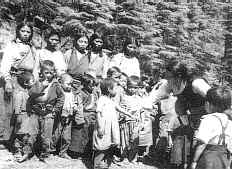
Cchering Dolma Tagla s dětmi
Following the Chinese occupation of Tibet in 1950 and His Holiness the Dalai Lama’s flight to India in 1959, it was quickly apparent that one of the most critical needs of Tibetan refugees was finding a means to care for the many children who had been orphaned or separated from their families during the arduous escape from their homeland. His Holiness promptly recognised that the future of Tibet and its people depended upon the younger generation. With this in mind and out of concern for the miserable conditions under which so many children were suffering, His Holiness proposed that a centre for destitute children be established in Dharamsala.
 On 17 May 1960, fifty-one children arrived from the road construction camps in Jammu, ill and malnourished. Mrs. Tsering Dolma Takla, the elder sister of His Holiness, volunteered to look after them. Initially these children were assigned to members of the Dalai Lama’s entourage, but before long the Government of India offered its assistance, renting Conium House to accommodate all the children together. At that time, the centre was under the name "Nursery for Tibetan Refugee Children."
On 17 May 1960, fifty-one children arrived from the road construction camps in Jammu, ill and malnourished. Mrs. Tsering Dolma Takla, the elder sister of His Holiness, volunteered to look after them. Initially these children were assigned to members of the Dalai Lama’s entourage, but before long the Government of India offered its assistance, renting Conium House to accommodate all the children together. At that time, the centre was under the name "Nursery for Tibetan Refugee Children."
Originally, the Nursery for Tibetan Refugee Children provided only basic care for children. When they reached the age of eight, they were sent to other residential schools established by the Government of India. But eventually this arrangement could not be continued as all the residential schools filled to capacity. This left the Nursery to find a solution to the problem of overcrowding. Thanks to the foresight and courage of Mrs. Jetsun Pema, then the Director, it was decided that the Nursery had to grow and expand despite many apparent obstacles.
A massive re-organization plan was set into motion. This included seeking help from private donors and international aid organizations. A period of hectic construction work ensued to provide for more houses and classrooms for children. The Nursery slowly took the shape of a small village with its own school and homes. In 1971, TCV took over the small nursery in Patlikuhl and expanded it into a residential school. In 1972, it was formally registered under the Societies Act as Tibetan Children’s Village, and it also became a full-fledged member of SOS Kinderdorf International.
 During this time when TCV was successfully emerging out of the critical early stages, the plight of the Tibetan children in remote areas such as Ladakh remained very grave. His Holiness the Dalai Lama was deeply concerned by the abject poverty and total lack of educational opportunities for the Tibetan refugees in Ladakh. Following His guidance, TCV, for the first time in its history, expanded beyond its confines in Himachal Pradesh State. In 1975, TCV Ladakh was founded, followed by TCV Bylakuppe in 1980. Both of these became full-fledged SOS Villages with their own schools and residential facilities.
During this time when TCV was successfully emerging out of the critical early stages, the plight of the Tibetan children in remote areas such as Ladakh remained very grave. His Holiness the Dalai Lama was deeply concerned by the abject poverty and total lack of educational opportunities for the Tibetan refugees in Ladakh. Following His guidance, TCV, for the first time in its history, expanded beyond its confines in Himachal Pradesh State. In 1975, TCV Ladakh was founded, followed by TCV Bylakuppe in 1980. Both of these became full-fledged SOS Villages with their own schools and residential facilities.
While TCV busied itself with the new responsibilities, the political situation in Tibet changed unexpectedly. China was forced to follow a lenient policy towards Tibet because of the international condemnation of its human rights record. Tibetans were allowed to visit their long-lost relations on both sides. This simultaneously provided new opportunities to parents to smuggle their children across the border to freedom. Thousand of children from Tibet flooded the main TCV at Dharamsala. To solve the overcrowding problem, TCV turned its poultry farm at Lower Dharamsala into a new residential school. Today, TCV School Lower Dharamsala is a high standard school with both primary and secondary school. It is entirely funded by Tibetan parents in exile.
In spite of TCV’s best efforts, the problem of absorbing the unabated flood of new refugees became very serious. In 1990, TCV over the Youth School in Bir and expanded its scope. With more and more children coming from Tibet, overcrowding of all our Villages led us to start a new senior secondary school at Gopalpur . In keeping with H. H. the Dalai Lama’s words on education that we should "counsel our children and encourage them to undergo specialised study in various fields," a multi-trade vocational training center was established and started in 1999. The 1995 flood at TCV Patlikuhl compelled us to relocate the school to a new location. The construction was started at Chauntra near Bir and has now become functional. Another TCV School Selakui in Dehradun was constructed in 2004 and has been running successfully. This year in June 2007, TCV School Selakui observed its first ever Class X Graduation Function and 43 children appeared for it. They had an excellent results with 100% pass percentage.
TCV Branches
All TCV Schools are affiliated with the Central Board of Secondary Education (CBSE), New Delhi, which is one of the national examining bodies in India. Over the years, TCV schools have successfully followed the board’s curriculum and have made the most of the opportunities given by the Indian system to gear the children’s education to fulfil our mission. After the successful completion of their school education, TCV continues to take the responsibility of sending the students for further education, depending on their intelligence and aptitude. For this, TCV has created various academic and vocational choices.
Handling TCV’s education endeavour is like piecing together a giant jigsaw puzzle of varied interests, abilities, and needs. To make it work, the TCV Education Office creates and co-ordinates all educational activities, including enriching human resource development.
CHILDREN’S VILLAGES & RESIDENTIAL SCHOOLS:
♣ TCV School Upper Dharamsala Click Here
♣ TCV School Bylakuppe Click Here
♣ TCV School Ladakh Click Here
♣ TCV School Suja Click Here
♣ TCV School Bir Click Here
♣ TCV School Gopalpur Click Here
♣ TCV School Lower D/Sala Click Here
♣ TCV School Chauntra Click Here
♣ TCV School Selakui Click Here
DAY SCHOOLS & CRČCHES
♣ TCV Day School, Mcleod Ganj
♣ TCV Day School, PatlikuhlClick Here
♣ Crèches
VOCATIONAL TRAINING CENTRES
♣ Vocational Training Centre, DhasaClick Here
♣ Vocational Training Centre, ladakh
♣ Vocational Training Centre, Patlikuhl
♣ Vocational Training Centre, DehradunClick Here
YOUTH HOSTELS
♣ Tibetan Youth Hostel, Delhi
♣ Tibetan Youth Hostel, BangaloreClick Here
♣ Tibetan Youth Hostel, Mundgod
♣ Tibetan Youth Hostel, Chandigarh
 TCV, Dharamsala TCV, DharamsalaFounded: 1960 Number of kids: 2385 Altitude: 1800 m |
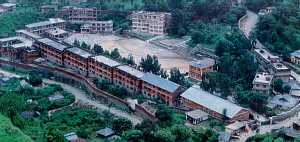 TCV school, lower Dharamsala TCV school, lower DharamsalaFounded: 1984 Number of kids: 732 Altitude: 1250 m |
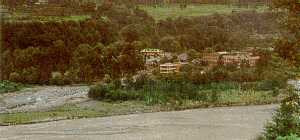 Škola TCV, Pathlikuhl Škola TCV, PathlikuhlZaloženo: 1968 Počet dětí: 632 Nadmořská výška: 1200 m Vedlejší projekty: 2 školy, 1 domov pro staré lidi |
|
SOS village, Ladakh
Před zahájením výstavby  Dnešní stav |
 SOS village, Bylakuppe SOS village, BylakuppeFounded: 1980 Number of kids: 1637 Altitude: 788 m Side projects: 1 šchool, 10 daily care centers, 2 youth hostels, 1 farm |
|
H.H. dalajlama during opening ceremony of the TCV school in Biru |
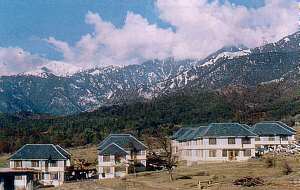 SOS village, Bir SOS village, BirFounded: 1993 Number of kids: 599 Altitude: 2080 m |
TCV Economy
Tibetan Children’s Villages is a charitable organisation, almost entirely dependent on the kindness and generosity of others. International aid agencies and individuals have always been sympathetic to the Tibetan situation and have responded well to our appeal for help. However, we always keep in mind that eventually Tibetans must become self-reliant and independent. Towards that goal, TCV initiated handicraft centres and other projects to generate an internal source of revenue.
Furthermore, in recent years Tibetan parents have begun to shoulder more of the financial burden by giving as much as they can. Yet, with so many needy children to look after and the overwhelming flood of new refugees that beseech TCV for help every year, it is impossible to sustain the life-giving works of TCV without help from outside. Therefore, the Tibetan Children’s Villages will always stand in need of assistance from its friends.
TCV SUJA-BIR
foto @ Miroslav Pošta
Our Support
| Year 2000 – 2000 USD | Receipt | |
| Year 2001 – 1000 USD | Receipt | |
| Year 2003 – 2000 USD | Receipt | |
| Year 2004 – 3000 USD | Receipt | |
| Year 2005 – 2000 USD | Receipt | |
| Year 2006 – 2000 USD | Receipt | |
| Year 2008 – 2220 USD | Receipt | Letter |
| Year 2009-1 – 5040 USD | Receipt | Letter |
| Year 2009-2 – 4020 USD | Receipt | Letter |
| Year 2009-3 – 5990 USD | Receipt | Letter |
How can I support?
Send a donation of any amount to the account of Potala collection managed as transparent bank account in Raiffeisenbank – account number:
If you wanted to support specifically this project select variable symbol 111.
You can sponsor a child. Further information on request to seminka@potala.cz.


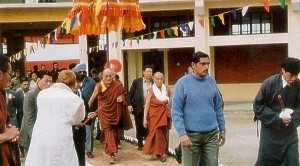 TCV school, Bir
TCV school, Bir